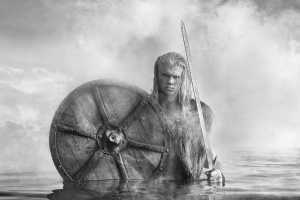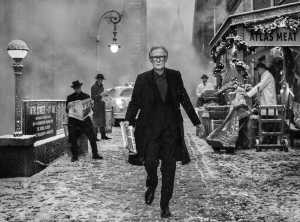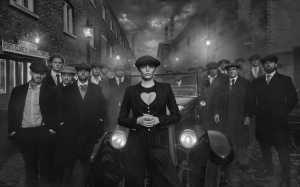“Everything’s possible,” says David Yarrow, and I’m not going to argue with a man who’s spent his life proving it. This is someone who photographed the 1986 World Cup Final at the tender age of 20, whose picture of Maradona celebrating with the trophy has become part of sporting history.
I meet Yarrow ahead of the launch of a new exhibition at Maddox Gallery. Stark cinematic portraits of Erling Haaland, Cara Delevingne and Bill Nighy are displayed alongside the wildlife photographs that made his name.
Not bad for someone who took 25 years out of photography to work in the City…
Square Mile: All of your photographs are either at or below the eyeline…
David Yarrow: If you photograph above the eyeline, it hints at an artificial encounter; it suggests you’re in a jeep. Ninety nine percent of people who photograph lions are in jeeps. [If it’s sharks] I’m in a cage in the water.
SM: How close do the animals get to you?
DY: Fifteen yards, something like that. Wildlife photography should be immersive. The photography of animals should be no different from the photography of people.
If you’re going to photograph people – whether it’s the most famous footballer in the world or Bill Nighy – you want to be close; you don’t want to be photographing with a long lens because it compresses distance and emotion. Whatever the subject matter – whether it’s human or not human – your camera should be close.
SM: You were named Young Scottish Photographer of the Year at the age of 20…
DY: To be called the best young photographer in Scotland, a) it wouldn’t be true, and b) it’s not the biggest nation in the world. I’m quite sceptical of awards. You get a lot of people saying, ‘Oh, they’re an award-winning photographer’ – that could mean that they won a prize at their local village fete. I think there are bigger badges of honour.

“The Dumbo location in Brooklyn encapsulates so much of what makes New York the most vibrant city on the planet. Those with a visual sensibility are drawn to the symmetry of the old warehouses, the industrial beauty of Manhattan Bridge and the Empire State Building peeking out in the background. To tell a story here, I played on the iconic Pretty Woman movie from 1990. Of course, we would be swapping New York for LA. Theatrical and smart, I knew Brooks Nader could play the character of Vivian well; after all, she dressed the same way for her Halloween night last year. Better still, her husband Billy, who is in the car, accompanied her as Ed.”
David Yarrow / Maddox Gallery
SM: What got you into photography?
DY: Sport. I love sport, I love watching sport. I was never good enough to play it professionally but I started to photograph sport and I suddenly realised I could get into the matches for free.
SM: How did you get into the 1986 World Cup Final?
DY: I was working for a football magazine – there were a lot more football magazines around in 1986 than there are now. Fifa had a rule that one photographer from every country that had qualified would be allowed on the pitch for the final. Scotland had got knocked out predictably early but I stayed on, whereas all the newspaper photographers went home. You’ve got to go the extra mile.
I was given a pitch pass for the final – it was in the days of film so I didn’t know what I’d got until two hours after the game, but I thought I’d got something. The Maradona photo has stood the test of time – I think it may be the third most-bought sports photograph of all time.
SM: Why did you go into finance?
DY: I think a bit of peer pressure, a bit of parental pressure. 1988 was a time when people had just watched Oliver Stone’s Wall Street and they all wanted to be Gordon Gekko or Bud Fox. It was very sexy to go and live right there; you lived a fast life in Manhattan. A lot of my friends were doing it.
I photographed the Olympics just before I had to make the decision. One of the tough things about sports photography is if you’ve got 100 photographers capturing one event, how could you do anything different? I was doing the bobsleigh in the Olympics; I thought I’d got a different picture and then 20 other people got the same one. I thought there was a little bit of saturation. It’s a crowded space.

"I needed a quiet day to shoot and that always pointed to a Sunday, but I also wanted a written reference as well as the architectural reference somewhere in the frame. The green street signposts of “Wall Street” were too high to incorporate into the picture, and I saw no real workable alternative. But by some extraordinary stroke of luck, when I found my shooting location on the cobbled street, there, smack in front of me, was a museum plate that spoke of Wall Street’s history. I had no idea it was there. This was not an easy shot, but we got there and to the best of my knowledge, we got there first."
David Yarrow / Maddox Gallery
SM: Did you enjoy working in the City?
DY: I spent 25 years doing it so there must have been some bits that I enjoyed. I learned a lot, made good friends. I grew up. I learned about business.
SM: What made you transition into photography full time?
DY: Well, I think the world changed with Lehman Brothers. When Lehman Brothers went down, it changed a lot of things for people in that industry. I thought for the rest of my life, I didn’t want to be hostage to things beyond my control. In 2008, so many people had their lives and careers destroyed for things that had nothing to do with them. I knew my business was going to go south.
It’s a tough thing, knowing at the age of 40 that you’re only going to go down in what you’re doing. You’ve reached the high point. That’s tough. To be always talking about yesteryears – there’s a line in Jerry Maguire, ‘We’ve all had our sad stories’ – you don’t want to be always talking about yesterdays.
I could see a growth model in photography that I couldn’t see in my other business. And it had always been my passion as well. But there were costs and bills to pay so I had to work out a business model – I spent many months and years working on that.
SM: Why did you transition away from wildlife photography?
DY: I don’t think what’s in front of the camera should bend back and affect your ability to take it. To me, it’s a bit obtuse to say, ‘Oh, David can’t photograph my daughter, he photographs zebras!’ How silly, the idea that what’s in front of the camera should affect your ability as a photographer. The camera’s just a piece of metal. Whether I’m photographing a wolf or a lion, or Bill or Cara, it’s the same principles. The motion, light, composition, balance.
I work with the same people because I know them well and they know me. But I don’t know what I’ll be photographing next year. It’s the journey that’s important, not what you’re doing that day.

“There is no more relevant footballer in the world than Erling Haaland. Aged just 23, he has many years ahead of him to continue breaking goal-scoring records at the same ferocious speed that has characterised his early career. He is a true one-off and a global sensation. I was fortunate that through our deep ties in Norway, Erling was contacted and encouraged to spend some time with me. There are many people to thank that this collaboration finally took place, none more so than his father, Alfie, who warmed to the idea that we could take an image that would raise money for causes close to their hearts in Norway. We worked on a narrative that would embrace Erling’s physical presence and distinctive Nordic look. It is difficult to think of another sportsman in the world who could wear the Viking look more naturally.”
David Yarrow / Maddox Gallery
SM: Is there anybody on your photography subject wish list?
DY: Oh, massively. I’ve been trying to photograph Willie Nelson for the last two years. I’ll get there. I’ve been trying to photograph the supreme leader of North Korea; I’ve been trying to photograph Vladimir Putin. I think the Putin one has to be put on a backburner! I’m always trying to photograph what other people think is very low probability to get. Everything’s possible.
SM: How did you get Haaland?
DY: It’s tough when you earn three million a week. But the starting point is philanthropy. Always think about charity.
SM: Your set-ups are very cinematic…
DY: Yes, I’m very inspired by film directors. Steven Spielberg is my hero. Martin Scorsese is another one as well.
SM: Any of these images have a particular story behind them?
DY: Well, the one on Wall Street we had to bring a wolf on American Airlines from Los Angeles. We had to take out first class to put the wolf in – the entire first row.

“Bill and I spitballed back and forth as to how to tell a story in a single frame. Bill is not someone to be pigeonholed and wanted the story to be set outside of London, so we settled on New York. From there the jigsaw puzzle came together. The meat packing district, a snowstorm and a nod to a memorable news story in the early 1960s. We chose Muhammad Ali, as we both felt this was a personality who transcended his own sphere of excellence.”
David Yarrow / Maddox Gallery
A Bill Nighy cameo...
Here our interview is interrupted by the arrival of one of Yarrow’s most recent subjects. Not the wolf, thankfully, but British acting legend Bill Nighy, who’s dropping by ahead of the evening’s launch party. He’s wearing an immaculate suit and clutching a novel. He looks so wonderfully Bill Nighy, it makes the heart sing. I managed to grab Nighy for a very brief chat…
SM: This is a stunning picture. [Left] How do you feel seeing yourself portrayed like this?
Bill Nighy: Well I’ve never been involved in anything like this before. I’ve only ever had my picture taken in the normal way for promotional purposes. I’ve never worked with a photographer like David before and there isn’t really a photographer like David.
To see this picture in the gallery alongside all these other great faces, it’s very different for me and it’s quite a shock. I’m honoured by the fact that he’s taken so much care and made such a beautiful image.
SM: Did he reach out to you?
BN: Yeah, he did. I’ve never been a subject in this way – photography for photography’s sake. For art’s sake. I’m not generally viewed in that way, I think – as much as I can figure out because I don’t read anything or look at anything. Because I’m so profoundly insecure about the way I look, and everything else in the world, I tend to… can I say ‘fuck about’?
SM: Yes, of course!
BN: I tend to fuck about and try to look as stupid as possible to preempt anyone else’s disdain. So to take what might be called a serious photograph is quite a departure for me. But I’m honoured to have been included in this pantheon. It’s great.
View on Instagram
An Englishman in New York, alongside other David Yarrow limited edition prints, is available to buy from maddoxgallery.com

